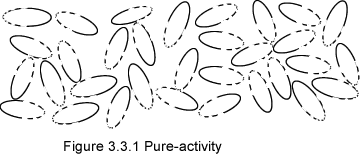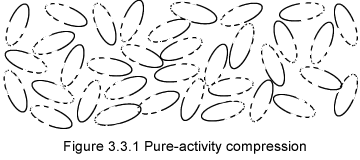The translation of light wave (§3.3)
Figure 3.3.1 provides the details of a wave. The still figure represents pure-activity using motion-occurrences rather than motion-quanta, as MQs turn into MOs while the wave is passing by.
  |
takes over both space and time
).Abstract of:
The hierarchy established by our human minds, and kept as is in the science of physics, which is that motion occurs in space, is in gravimotion tipped-over, down side (motion) up (above both space and time).
...
Pure-activity for space (§3.1)
...
The hierarchy established by our human minds, and kept as is in the science of physics, which is that motion occurs in space, is in gravimotion tipped-over, down side (motion) up (above both space and time).
...
A cycle of the wave, at present or what is represented on the screen, amounts to a motion condensing the MOs in a heap, followed by a depletion of same magnitude but in reverse in number of MOs.
The cycles once through leave no trace behind; their initiation (by a source) and transfer amount to local motion occurrences MOs and MQs thrust increases / decreases (accelerations decelerations).
A single cycle internal loss of equilibrium, when averaged over the whole cycle, is nevertheless neutral.
And because motion occurrences are the combination of faster MOs yet, the motion of a cycle of light has less thrust than the overall motion thrust out of which it is combined.
Only pure-activity occurs as pure motion-quanta.
One can imagine that motions faster than light (MOs faster than light MOs) may occur in Nature, MOs which would yet be slower than motion quanta MQs.
Gravity waves
 One can also imagine a wave translated through inclinations of motion-occurrences, which is the essence of gravity in gravimotion; the depression, compression stages are replaced with inclinations variations; for instance the front edge of the wave could have more inclinations in the direction of the wave than Maxwellian distribution has, while the trailing edge would have inclinations opposite that direction.
One can also imagine a wave translated through inclinations of motion-occurrences, which is the essence of gravity in gravimotion; the depression, compression stages are replaced with inclinations variations; for instance the front edge of the wave could have more inclinations in the direction of the wave than Maxwellian distribution has, while the trailing edge would have inclinations opposite that direction.Figure 3.3.2 represents this situation in I and III Maxwellian motion is represented, in II the orientations only of the MO's and MQ's are modified; their concentration remains the same as in I and III.
A wave is transmission of a cyclic motion through local disturbance of pure-activity; while the activity during a cycle departs from the Maxwellian pure-activity, the MOs overall activity of 1 cycle nevertheless averages to pure-activity.
As such light and gravity waves over long displacements, which coincide to wider spread in volume, dissolve back in pure activity, without any loss of motion (no energy loss while disappearing).